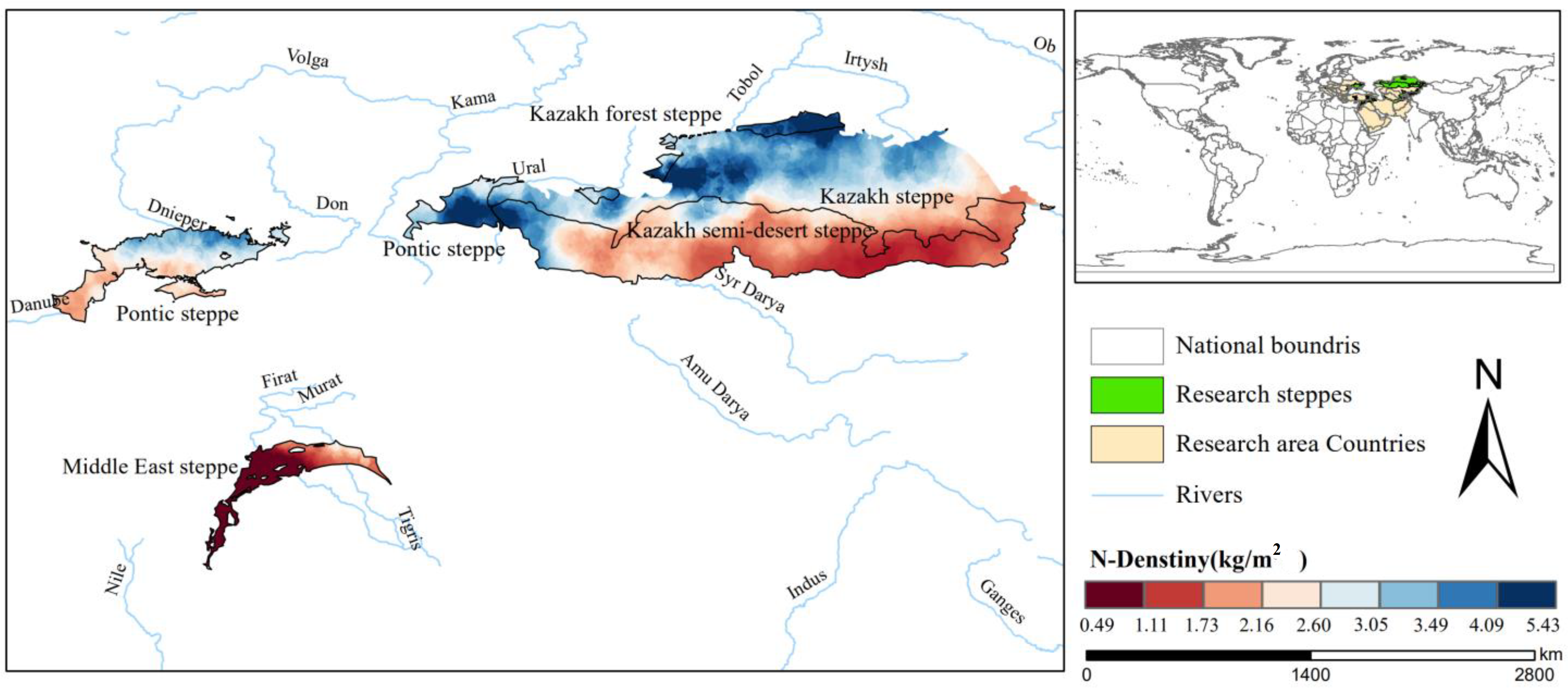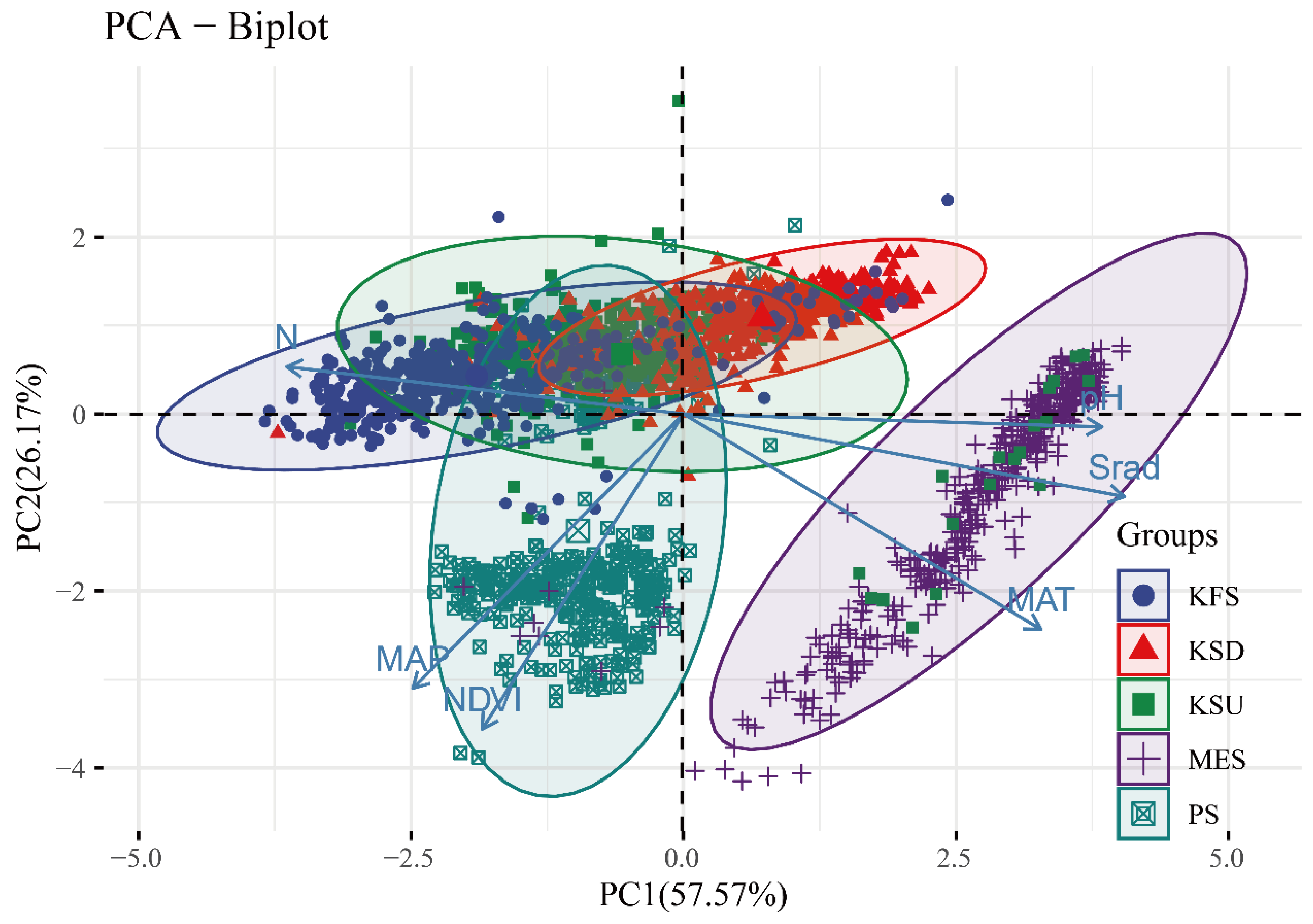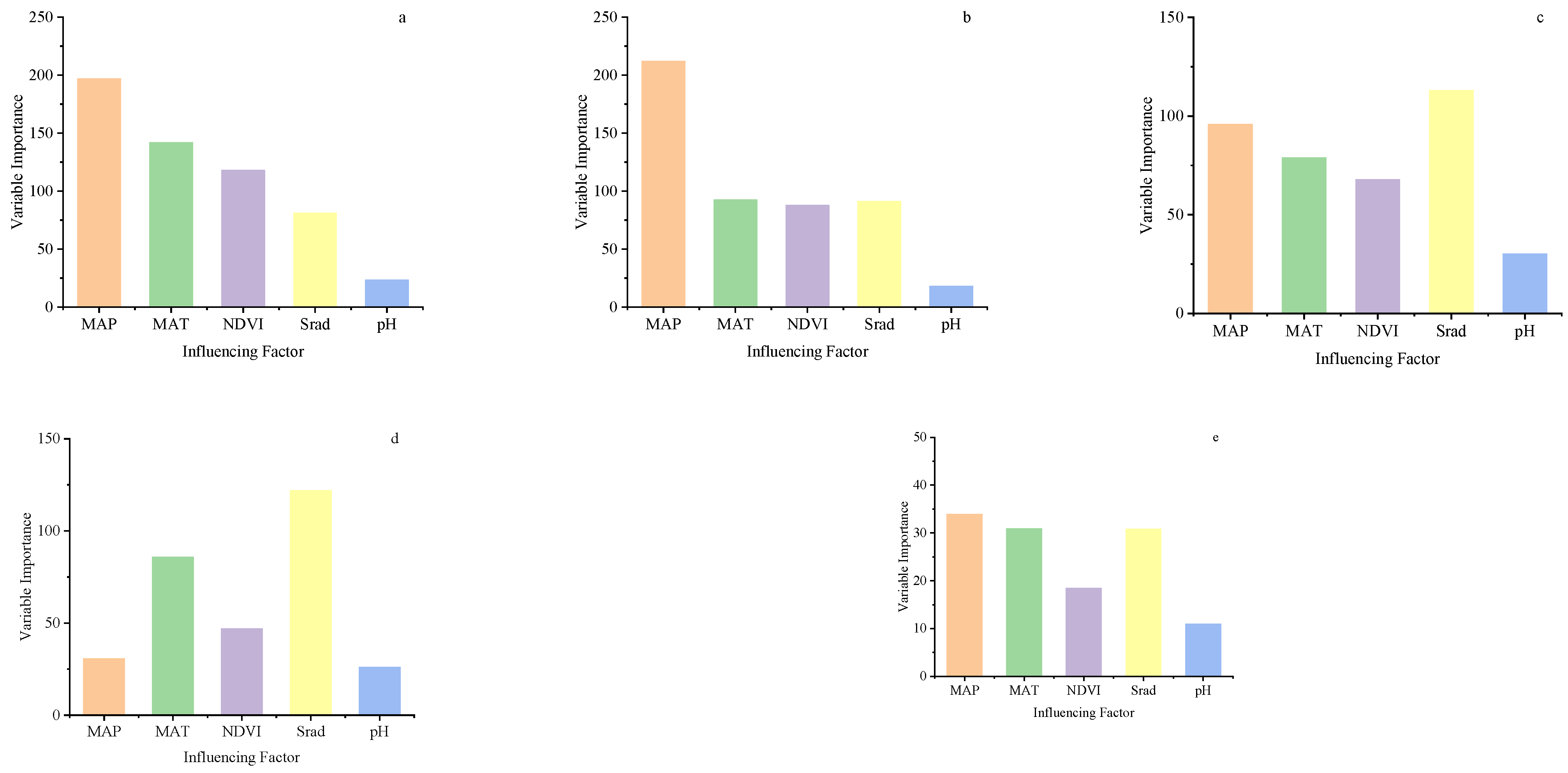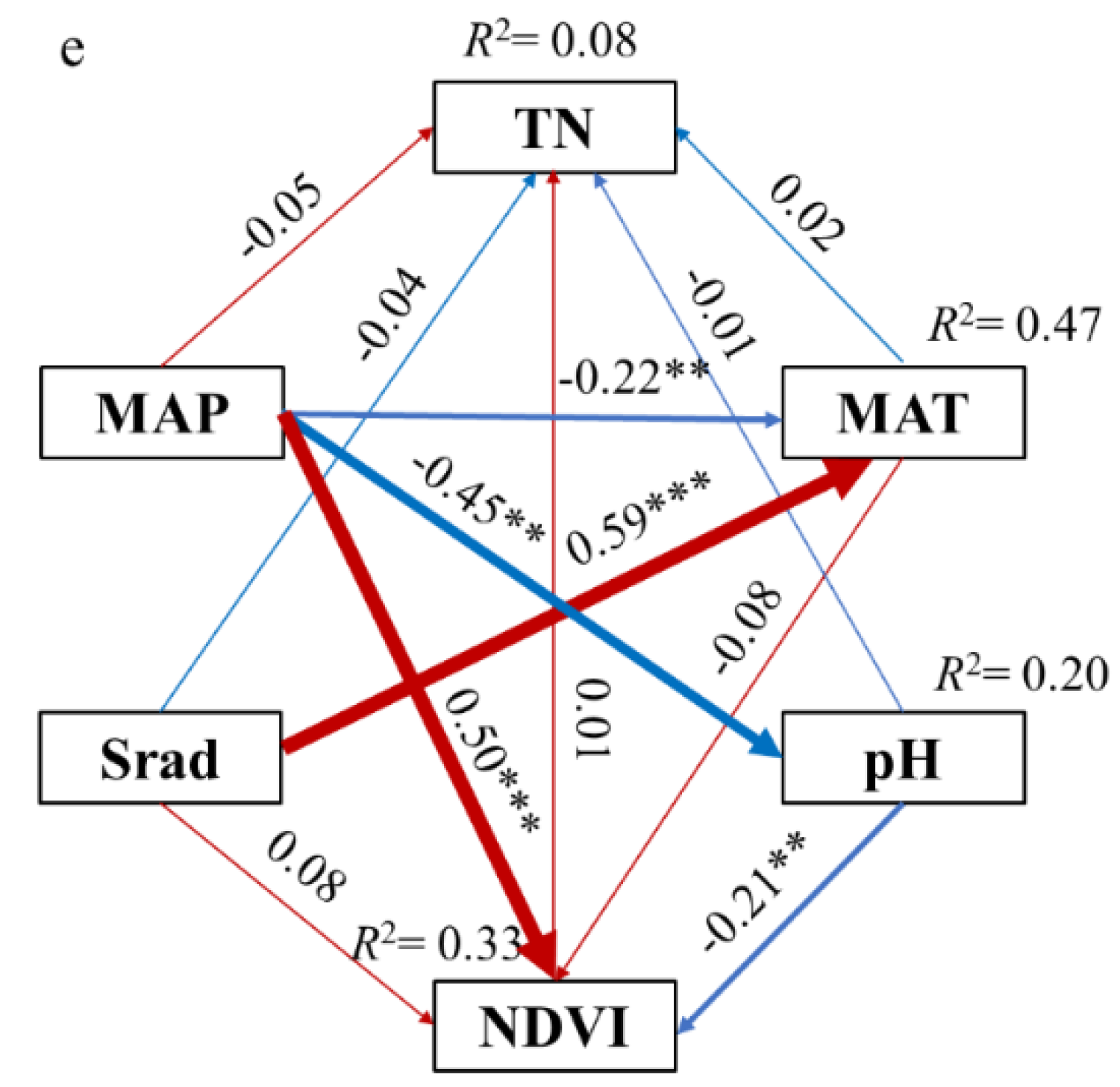The Spatial Distribution of Soil Nitrogen Storage and the Factors That Influence It in Central Asia’s Typical Arid and Semiarid Grasslands
Abstract
:1. Preface
2. Scope of the Study Area
3. Materials and Methods
3.1. Data Sources
3.2. Calculation of TN Density and Storage Capacity
3.3. Analysis Methods
4. Results
4.1. Descriptive Statistical Analysis of Soil N Content and Environmental Variables
4.2. Spatial Distribution Patterns of Soil N Stocks and N Content (0–100 cm) in Typical Central Asian Grasslands
4.3. Soil N Content in Relation to Environmental Factors
5. Discussion
5.1. Estimates and Percentages of Soil N Stocks in Five Typical Grasslands in Central Asia
5.2. Drivers of Change in Soil N Content in Five Typical Central Asian Grasslands
6. Conclusions
Author Contributions
Funding
Institutional Review Board Statement
Data Availability Statement
Conflicts of Interest
References
- Gruber, N.; Galloway, J.N. An Earth-system perspective of the global nitrogen cycle. Nature 2008, 451, 293–296. [Google Scholar] [CrossRef]
- Yang, Y.H.; Ma, W.H.; Mohammat, A.; Fang, J.-Y. Storage, Patterns and Controls of Soil Nitrogen in China. Pedosphere 2007, 17, 776–785. [Google Scholar] [CrossRef]
- Zeng, Q.; Lal, R.; Chen, Y.; Quanchao, Z. Soil, Leaf and Root Ecological Stoichiometry of Caragana korshinskii on the Loess Plateau of China in Relation to Plantation Age. PLoS ONE 2017, 12, e0168890. [Google Scholar] [CrossRef] [PubMed] [Green Version]
- Luo, Y.Q.; Su, B.; Currie, W.S.; Dukes, J.S.; Finzi, A.; Hartwig, U.; Hungate, B.; McMurtrie, R.E.; Oren, R.; Parton, W.J.; et al. Progressive nitrogen limitation of ecosystem responses to rising atmospheric carbon dioxide. Bioscience 2004, 54, 731–739. [Google Scholar] [CrossRef] [Green Version]
- Shi, X.M.; Li, X.G.; Long, R.J.; Singh, B.P.; Li, L.T.; Li, F.M. Dynamics of soil organic carbon and nitrogen associated with phys-ically separate fractions in a grassland-cultivation sequence in the Qinghai-Tibet plateau. Biol. Fertil. Soils 2010, 46, 103–112. [Google Scholar] [CrossRef]
- in’t Zandt, D.; Brink, A.; de Kroon, H.; Visser, E.J.W. Plant-soil feedback is shut down when nutrients come to town. Plant Soil 2019, 439, 541–551. [Google Scholar] [CrossRef] [Green Version]
- Schimel, D.S. Terrestrial ecosystems and the carbon cycle. Glob. Chang. Biol. 1995, 1, 77–91. [Google Scholar] [CrossRef]
- Pinder, R.W.; Bettez, N.D.; Bonan, G.B.; Greaver, T.L.; Wieder, W.R.; Schlesinger, W.H.; Davidson, E.A. Impacts of human al-teration of the nitrogen cycle in the US on radiative forcing. Biogeochemistry 2013, 114, 25–40. [Google Scholar] [CrossRef] [Green Version]
- Harpole, W.S.; Potts, D.L.; Suding, K.N. Ecosystem responses to water and nitrogen amendment in a California grassland. Glob. Chang. Biol. 2007, 13, 2341–2348. [Google Scholar] [CrossRef]
- Hodgson, J. Grazing Management; John Willey and Sons Inc.: New York, NY, USA, 1990. [Google Scholar]
- Batjes, N.H. Total carbon and nitrogen in the soils of the world. Eur. J. Soil Sci. 2014, 65, 10–21. [Google Scholar] [CrossRef]
- Tian, H.Q.; Wang, S.Q.; Liu, J.; Pan, S.; Chen, H.; Zhang, C.; Shi, X. Patterns of soil nitrogen storage in China. Glob. Biogeochem. Cycles 2006, 20. [Google Scholar] [CrossRef]
- Suo, Y.X.; Wang, Z.X.; Liu, C.; Yu, B. Relationship between NDVI and precipitation and temperature in middle Asia during 1982–2002. Resour. Sci. 2009, 31, 1422–1429. [Google Scholar]
- Lal, R. Soil Carbon Sequestration Impacts on Global Climate Change and Food Security. Science 2004, 304, 1623–1627. [Google Scholar] [CrossRef] [Green Version]
- Nasholm, T.; Ekblad, A.; Nordin, A.; Giesler, R.; Högberg, M.; Högberg, P. Boreal forest plants take up organic nitrogen. Nature 1998, 392, 914–916. [Google Scholar] [CrossRef]
- Liu, S.; Qin, T.; Dong, B.; Shi, X.; Lv, Z.; Zhang, G. The Influence of Climate, Soil Properties and Vegetation on Soil Nitrogen in Sloping Farmland. Sustainability 2021, 13, 1480. [Google Scholar] [CrossRef]
- Huang, F.; Wang, P.; Zhang, J. Grasslands changes in the Northern Songnen Plain, China during 1954–2000. Env. Monit Assess 2012, 184, 2161–2175. [Google Scholar] [CrossRef] [PubMed]
- Breuer, L.; Huisman, J.; Keller, T.; Frede, H.-G. Impact of a conversion from cropland to grassland on C and N storage and related soil properties: Analysis of a 60-year chronosequence. Geoderma 2006, 133, 6–18. [Google Scholar] [CrossRef]
- Freschet, G.T.; Violle, C.; Bourget, M.Y.; Scherer-Lorenzen, M.; Fort, F. Allocation, morphology, physiology, architecture: The multiple facets of plant above- and below- ground responses to resource stress. New Phytol. 2018, 219, 1338–1352. [Google Scholar] [CrossRef]
- Nie, X.Q.; Xiong, F.; Yang, L.C.; Li, C.; Zhou, G. Soil Nitrogen Storage, Distribution, and Associated Controlling Factors in the Northeast Tibetan Plateau Shrublands. Forests 2017, 8, 416. [Google Scholar] [CrossRef] [Green Version]
- Zhang, C.; Wang, Y.; Jia, X.; Shao, M. Estimates and determinants of soil organic carbon and total nitrogen stocks up to 5 m depth across a long transect on the Loess Plateau of China. J. Soils Sediments 2021, 21, 748–765. [Google Scholar] [CrossRef]
- Cheng, Y.; Wang, J.; Mary, B.; Zhang, J.-B.; Cai, Z.-C.; Chang, S.X. Soil pH has contrasting effects on gross and net nitrogen mineralizations in adjacent forest and grassland soils in central Alberta, Canada. Soil Biol. Biochem. 2013, 57, 848–857. [Google Scholar] [CrossRef]
- Brunson, M.W.; Steel, B.S. Sources of variation inattitudes and beliefs about federal grassland management. J. Rangel. Manag. 1996, 49, 69–75. [Google Scholar] [CrossRef] [Green Version]
- Jobbágy, E.G.; Jackson, R.B. The vertical distribution of soil organic carbon and its relation to climate and vegetation. Ecol. Appl. 2000, 10, 423–436. [Google Scholar] [CrossRef]
- Miller, A.J.; Amundson, R.; Burke, I.; Yonker, C. The effect of climate and cultivation on soil organic C and N. Biodegradation 2004, 67, 57–72. [Google Scholar] [CrossRef]
- Lv, H.; Zhan, T.; Ma, J. Effect of lime and calcium-magnesium phosphate fertilizers on baking tobacco production and soil acidity regulation. Ecol. Environ. Sci. 2004, 13, 379–381. [Google Scholar]
- Delgado-Baquerizo, M.; Maestre, F.T.; Gallardo, A. Decoupling of nutrient cycles as a function of aridity in globa2l dryland soils. Nature 2013, 502, 672–676. [Google Scholar] [CrossRef]
- Wu, H.; Guo, Z.; Peng, C. Distribution and storage of soil organic carbon in China. Glob. Biogeochem. Cycles 2003, 17. [Google Scholar] [CrossRef]
- Chen, Y.; Xu, Z.; Hu, H.; Hu, Y.; Hao, Z.; Jiang, Y.; Chen, B. Responses of ammonia-oxidizing bacteria and archaea to nitrogen fertilization and precipitation increment in a typical temperate steppe in Inner Mongolia. Appl. Soil Ecol. 2013, 68, 36–45. [Google Scholar] [CrossRef]
- Wieder, W.; Bonan, G.B.; Allison, S.D. Global soil carbon projections are improved by modelling microbial processes. Nat. Clim. Chang. 2013, 3, 909–912. [Google Scholar] [CrossRef]
- Zhang, Y. Research advance on soil erosion in loess hilly-gully region. J. Soil Water Conserv. 2001, 15, 121–128. [Google Scholar]
- Wu, J.; Liu, X.; Xiong, Z. Soil characteristics and their relationship with tobacco quality in Fujian’s tobacco areas. Acta Tab. Sin. 1996, 6, 49–53. [Google Scholar]
- Plaza, C.; Zaccone, C.; Sawicka, K.; Méndez, A.M.; Tarquis, A.; Gascó, G.; Heuvelink, G.B.M.; Schuur, E.A.G.; Maestre, F.T. Soil resources and element stocks in drylands to face global issues. Sci. Rep. 2018, 8, 1–8. [Google Scholar] [CrossRef]
- Adhikari, K.; Owens, P.R.; Libohova, Z.; Miller, D.M.; Wills, S.A.; Nemecek, J. Assessing soil organic carbon stock of Wisconsin, USA andits fate under future land use and climate change. Sci. Total Environ. 2009, 667, 833–845. [Google Scholar] [CrossRef] [PubMed]
- Fierer, N.; Carney, K.M.; Horner-Devine, M.C.; Megonigal, J.P. The biogeography of ammonia-oxidizing bacterial communities in soil. Micro. Ecol. 2009, 58, 435–445. [Google Scholar] [CrossRef]
- Mcgill, W.B. The physiology and biochemistry of soil organisms. In Soil Microbiology, Ecology and Biochemistry, 3rd ed.; Academic Press: Cambridge, MA, USA, 2007; pp. 231–256. [Google Scholar]
- Schlesinger, W.H. Biogeochemistry: An Analysis of Global Change. Sea 1991, 254–293. [Google Scholar] [CrossRef]
- Kang, L.; Han, X.; Zhang, Z.; Sun, O. Grassland ecosystems in China: Review of current knowledge and research advancement. Philos. Trans. R. Soc. B Biol. Sci. 2007, 362, 997–1008. [Google Scholar] [CrossRef] [PubMed]







| Grassland Name | Parameter | N (g/kg) | Bulk (N/m3) | MAT (°C) | MAP (mm) | Srad (W/m2) | pH | NDVI |
|---|---|---|---|---|---|---|---|---|
| PS | Mean | 2.28 ± 0.74 | 1.29 ± 0.07 | 12.46 ± 2.72 | 413.01 ± 90.78 | 148.04 ± 7.32 | 7.32 ± 0.29 | 0.20 ± 0.05 |
| Max | 5.06 | 1.50 | 17.51 | 531.38 | 165.05 | 8.00 | 0.35 | |
| Min | 1.11 | 1.03 | 3.68 | 198.86 | 136.97 | 6.20 | −0.05 | |
| CV | 0.33 | 0.05 | 0.22 | 0.22 | 0.05 | 0.04 | 0.24 | |
| MES | Mean | 0.88 ± 0.48 | 1.49 ± 0.03 | 26.64 ± 2.20 | 277.26 ± 145.09 | 213.31 ± 4.64 | 7.96 ± 0.39 | 0.13 ± 0.04 |
| Max | 2.39 | 1.61 | 31.85 | 806.29 | 227.68 | 8.20 | 0.34 | |
| Min | 0.30 | 1.36 | 20.40 | 51.19 | 205.54 | 0.00 | 0.06 | |
| CV | 0.55 | 0.02 | 0.08 | 0.52 | 0.02 | 0.05 | 0.33 | |
| KS | Mean | 2.26 ± 0.80 | 1.25 ± 0.06 | 3.13 ± 1.77 | 309.27 ± 37.81 | 147.93 ± 9.32 | 7.26 ± 0.33 | 0.12 ± 0.02 |
| Max | 6.16 | 1.42 | 9.07 | 425.81 | 172.44 | 8.00 | 0.24 | |
| Min | 0.91 | 0.96 | −0.02 | 202.29 | 128.39 | 5.50 | −0.09 | |
| CV | 0.35 | 0.05 | 0.57 | 0.12 | 0.06 | 0.05 | 0.19 | |
| KSD | Mean | 1.57 ± 0.62 | 1.35 ± 0.06 | 7.03 ± 2.60 | 208.32 ± 58.48 | 166.94 ± 9.30 | 7.72 ± 0.26 | 0.10 ± 0.02 |
| Max | 4.67 | 1.50 | 12.46 | 378.71 | 189.38 | 8.20 | 0.20 | |
| Min | 0.84 | 0.95 | 1.14 | 122.14 | 144.47 | 6.60 | 0.01 | |
| CV | 0.39 | 0.04 | 0.37 | 0.28 | 0.06 | 0.03 | 0.17 | |
| KFS | Mean | 3.13 ± 0.72 | 1.15 ± 0.08 | 1.80 ± 0.68 | 371.56 ± 28.15 | 135.64 ± 7.85 | 6.76 ± 0.38 | 0.15 ± 0.02 |
| Max | 5.66 | 1.34 | 3.07 | 496.52 | 159.15 | 7.80 | 0.21 | |
| Min | 1.36 | 0.72 | 0.71 | 298.90 | 125.28 | 5.90 | 0.01 | |
| CV | 0.23 | 0.07 | 0.38 | 0.08 | 0.06 | 0.06 | 0.16 |
| Contents (g/kg) | Density (kg/m3) | Storage (Pg) | ||||||||
|---|---|---|---|---|---|---|---|---|---|---|
| Grassland Name | Square (km2) | 0–30 | 0–50 | 0–100 | 0–30 | 0–50 | 0–100 | 0–30 | 0–50 | 0–100 |
| PS | 287384 | 3.76 | 3.37 | 3.02 | 4.81 | 4.29 | 3.87 | 0.48 | 0.63 | 1.11 |
| MES | 132600 | 1.10 | 1.02 | 0.99 | 1.64 | 1.51 | 1.47 | 0.06 | 0.12 | 0.19 |
| KS | 736932 | 3.30 | 3.00 | 2.77 | 4.09 | 3.72 | 3.43 | 0.90 | 1.64 | 2.53 |
| KSD | 688550 | 2.32 | 2.30 | 1.94 | 3.11 | 2.81 | 2.60 | 0.64 | 1.16 | 1.79 |
| KFS | 44884 | 4.14 | 3.85 | 3.63 | 4.74 | 4.39 | 4.15 | 0.64 | 1.18 | 1.87 |
| Component | Eigenvalue | PV(%) | CPV(%) |
|---|---|---|---|
| 1 | 1.86 | 57.57 | 57.57 |
| 2 | 1.25 | 26.17 | 83.74 |
| 3 | 0.62 | 6.30 | 90.04 |
| 4 | 0.54 | 4.79 | 94.83 |
| 5 | 0.51 | 4.30 | 99.13 |
| 6 | 0.23 | 0.86 | 100 |
| Parameter | PC1 | PC2 |
|---|---|---|
| Eigenvalue | 0.576 | 0.262 |
| Cumulative(%) | 57.57 | 83.75 |
| N | 0.93 | 0.45 |
| MAT | 1.59 | −1.99 |
| MAP | 1.27 | 0.45 |
| Srad | 0.27 | −2.29 |
| pH | 0.68 | 0.07 |
| NDVI | 0.92 | −1.7 |
Publisher’s Note: MDPI stays neutral with regard to jurisdictional claims in published maps and institutional affiliations. |
© 2022 by the authors. Licensee MDPI, Basel, Switzerland. This article is an open access article distributed under the terms and conditions of the Creative Commons Attribution (CC BY) license (https://creativecommons.org/licenses/by/4.0/).
Share and Cite
Chen, Y.; Zhang, S.; Wang, Y.; Abzhanov, T.; Sarsekova, D.; Zhumabekova, Z. The Spatial Distribution of Soil Nitrogen Storage and the Factors That Influence It in Central Asia’s Typical Arid and Semiarid Grasslands. Diversity 2022, 14, 459. https://doi.org/10.3390/d14060459
Chen Y, Zhang S, Wang Y, Abzhanov T, Sarsekova D, Zhumabekova Z. The Spatial Distribution of Soil Nitrogen Storage and the Factors That Influence It in Central Asia’s Typical Arid and Semiarid Grasslands. Diversity. 2022; 14(6):459. https://doi.org/10.3390/d14060459
Chicago/Turabian StyleChen, Yusen, Shihang Zhang, Yongdong Wang, Talgat Abzhanov, Dani Sarsekova, and Zhazira Zhumabekova. 2022. "The Spatial Distribution of Soil Nitrogen Storage and the Factors That Influence It in Central Asia’s Typical Arid and Semiarid Grasslands" Diversity 14, no. 6: 459. https://doi.org/10.3390/d14060459
APA StyleChen, Y., Zhang, S., Wang, Y., Abzhanov, T., Sarsekova, D., & Zhumabekova, Z. (2022). The Spatial Distribution of Soil Nitrogen Storage and the Factors That Influence It in Central Asia’s Typical Arid and Semiarid Grasslands. Diversity, 14(6), 459. https://doi.org/10.3390/d14060459







